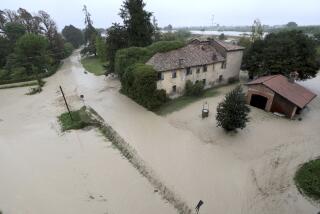Islamic State may be losing ground, but its recapture of Palmyra in Syria shows it is still a threat
When the Syrian army, backed by relentless Russian airstrikes, beat back Islamic State from the ancient city of Palmyra early this year, it marked the first in a string of significant defeats against the extremist group in the country.
But that victory appeared to have been short-lived. On Sunday, almost nine months after the jihadists’ retreat, Islamic State overran Palmyra once more, the group and activists said. The advance raises questions about recent pronouncements of the group’s weakness — as well as Damascus’ ability to hold territories for which it has paid heavily in men and materiel.
It also suggests a doubling down on Syria by Islamic State and a return to the time before it proclaimed its “caliphate” in 2014. It had been all but defeated in Iraq then, but regrouped around the Syrian-Iraqi border before launching a blitz offensive that claimed a large swath of Iraqi and Syrian territory.
A statement released by Islamic State on social media Sunday said the “soldiers of the caliphate had secured their control over all of Palmyra city… after three days of violent clashes.”
It also issued a series of images showing its fighters with tanks, and pickups mounted with heavy guns, attacking what it said was the Jazal oil fields, northwest of Palmyra.
Amaq, a news agency affiliated with the group, posted a video on Sunday purporting to show Palmyra after Islamic State soldiers had arrived on its outskirts. It coincided with a statement saying the takeover had come after the collapse of the Syrian army’s defenses.
Nasser Abdul Aziz, head of an activist documentation group with members inside the city, said in an interview on social media that Islamic State had taken Palmyra, and had begun broadcasting via loudspeakers that it was now safe for civilians to come out.
He added that hundreds of the jihadists, backed by heavy armor, had crossed from neighboring Iraq. They then massed at Raqqah, approximately 100 miles to the northeast of Palmyra and Islamic State’s de-facto capital in Syria.
As they marched towards the ancient city, they swatted away guard units in the oil fields to the east before storming Palmyra itself.
The Syrian Observatory for Human Rights, a pro-opposition monitoring group with activists throughout the country, said the assault had killed approximately 120 pro-government troops.
The Palmyra Coordination Committee, which supports rebels fighting to overthrow Syrian President Bashar Assad, posted images purporting to show Islamic State fighters roaming Palmyra’s streets as they conducted house-to-house searches for government supporters. Another picture depicted Islamic State’s notorious white-on-black flag flying above a number of buildings.
Later on Sunday, the governor of Homs province, which includes Palmyra, said in an interview with the semi-official Ikhbaria television channel that Syrian forces had made a decision to withdraw from central Palmyra and fall back to the city’s perimeter.
The Syrian state news agency, SANA, however, said Syrian army units were “continuing their clashes with the terrorists from Daesh around Palmyra despite the reinforcements that may arrive for the group from Raqqah.” Daesh is the Arabic acronym for Islamic State.
The jihadists succeeded in subduing the city despite a barrage of 64 strikes by Russian warplanes, according to the Russian Defense Ministry. The attacks, it said, had killed more than 300 militants and destroyed scores of vehicles.
Sunday’s assault echoed the lightning offensive that had first delivered Palmyra into the jihadists’ hands in May 2015, when they crossed the open desert with a convoy that quickly overpowered government troops.
Following the group’s takeover, it staged a gruesome mass execution of suspected government collaborators in the remains of an ancient Roman theater, once home to an important music festival before the almost six-year crisis devastating the country.
The group also imposed its strict interpretation of Sharia, or Islamic law, and declared the priceless artifacts found in Palmyra to be pagan.
The jihadists smashed statues and busts. They blew up temples, as well as the iconic triumphal arch, months after beheading Khaled Asaad, the retired director of Palmyra’s museum.
But in March, Russia and Syrian warplanes pounded Islamic State positions, opening the path for Syrian army troops, government militiamen and Shiite irregulars from Lebanon, Iraq, Iran and Afghanistan to mount a difficult fight to seize the city.
It was the beginning of a string of setbacks for Islamic State and the erosion of the territories under its sway.
Sunday’s advance, Russia and activists said, relied on jihadists diverted from the battle for Mosul, now the epicenter of a massive campaign by the U.S.-led coalition and Iraqi forces to wrest the city from the jihadists’ hands.
The offensive’s plans call for an exit to be provided from the city’s western flank allowing Islamic State fighters to escape towards Syria.
Once out of Mosul, they would face a gantlet of coalition planes and Popular Mobilization Forces, Iraqi Shiite-dominated paramilitary groups dispatched to block the jihadists’ flight across the roughly 372-mile border between the two countries.
Yet much of its length remains in Islamic State hands.
The Russian Center for Reconciliation, the Russian military’s monitor in Syria, said its reconnaissance had registered the arrival of 5,000 Islamic State militants in Raqqah and the eastern province of Deir ez Zor from Mosul.
Palmyra’s loss also came as the Syrian army was on the cusp of regaining all of Aleppo, a city divided for more than four years into distinct cantons of government and opposition control. With government troops bearing down on the last of the opposition groups inside the city, another costly mission to snatch Palmyra would ease the pressure on the rebels.
Bulos is a special correspondent
MORE WORLD NEWS
Islamic State militants reenter ancient Syrian city of Palmyra
Pentagon will send 200 more troops to Syria
Supposedly defeated, Boko Haram blamed for killing 30 in suicide attack
UPDATES:
12:45 p.m.: This article has been updated throughout with staff reporting, background, analysis.
This article was originally posted at 5:20 a.m.
More to Read
Sign up for Essential California
The most important California stories and recommendations in your inbox every morning.
You may occasionally receive promotional content from the Los Angeles Times.











